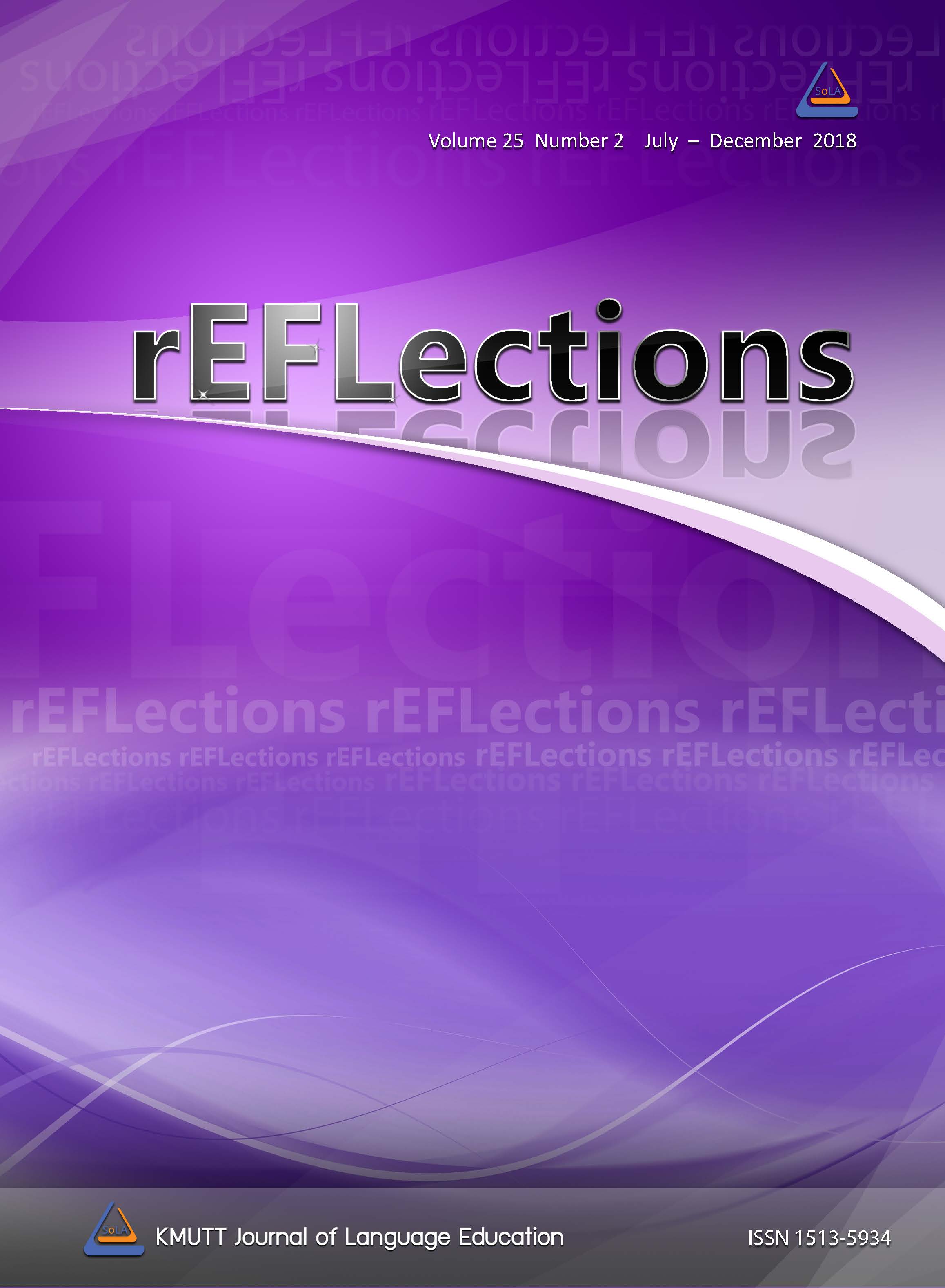Investigating the Outlines of Semantic Prosody in Thai
Main Article Content
Abstract
To date, there have been relatively few studies of semantic prosody in languages other than English. This study primarily aims to implement the two major approaches to semantic prosody in the literature on the Thai language for the first time in order to set out the parameters for subsequent research in this area. Three Thai words were selected for analysis: /kreeŋcay/ ‘considerate’, /kɔ̀ɔhâykə̀ət/ ‘cause’, and /chɔɔ̂ p/ ‘like’ (in the sense of enjoying (doing) something). Each word was investigated using two contrasting approaches: one oriented towards contrasting negative and positive polarity of evaluation and the other oriented around the Sinclairian concept of the Extended Unit of Meaning. The findings reveal that both approaches can be viable routes to examine the semantic prosody of the words under study, although they are useful for different purposes.
Article Details
References
Baker, P., & Egbert, J. (2016). Introduction. In P. Baker & J. Egbert (Eds.), Triangulating methodological approaches in corpus-linguistic research (pp. 1-19). London, England: Routledge.
Bednarek, M. (2008). Semantic preference and semantic prosody re-examined. Corpus Linguistics and Linguistic Theory, 4(2), 119-39.
Dam-Jensen, H., & Zethsen, K. (2008). Translator awareness of semantic prosodies. Target, 20(2), 203-21.
Hardie, A. (2012). CQPweb – combining power, flexibility and usability in a corpus analysis tool. International Journal of Corpus Linguistics, 17(3), 380-409.
Hardie, A. (n.d.) Retrieved from https://cqpweb.lancs.ac.uk/
Hardie, A. (forthcoming). A dual sort-and-filler strategy for statistical analysis of collocation, keywords, and lockwords.
Hunston, S. (2002). Corpora in Applied Linguistics. Cambridge, England: Cambridge University Press.
Hunston, S., & Francis, G. (2000). Pattern Grammar: A Corpus-Driven Approach to the Lexical Grammar of English. Amsterdam, The Netherlands: John Benjamins.
Iwasaki, S., & Ingkaphirom, P. (2005). A reference grammar of Thai. Cambridge, England: Cambridge University Press.
Louw, W. E. (1993). Irony in the text or insincerity in the writer? The diagnostic potential of semantic prosodies. In M. Baker, G. Francis & E. Tognini-Bonelli (Eds.), Text and technology: In honour of John Sinclair (pp. 157-76). Amsterdam, The Netherlands: John Benjamins.
Morley, J., & Partington, A. (2009). A few frequently asked questions about semantic - or evaluative - prosody. International Journal of Corpus Linguistics, 14(2), 139-158.
Munday, J. (2013). Looming large: A cross-linguistic analysis of semantic prosodies in comparable reference corpora. In A. Kruger, K. Wallmach & J. Munday (Eds.), Corpus-based translation studies: Research and applications (pp. 169-186). London, England: Bloomsbury Academic.
Partington, A. (1998). Patterns and meaning: Using corpora for English language research and teaching. Amsterdam, The Netherlands: John Benjamin.
Partington, A. (2004). “Utterly content in each other’s company”: Semantic prosody and semantic preference. International Journal of Corpus Linguistics, 9(1), 131-56.
Partington, A. (2014). Evaluative prosody. In K. Aijmer & C. Rühlemann (Eds.), The handbook of corpus pragmatics (pp. 532-80). Cambridge, England: Cambridge University Press.
Sinclair, J. (2004). Trust the text: Language, corpus and discourse. London, England: Routledge.
Sinclair, J., Jones, S., Daley, R. & Krishnamurthy, R. (2004). English collocational studies: The Osti report. London, England: Continuum.
Stewart, D. (2010). Semantic prosody: A critical evaluation. London, England: Routledge.
Stubbs, M. (1995). Collocations and semantic profiles: on the cause of the trouble with quantitative
studies. Functions of Language, 2(1), 23-55. Retrieved from https://www.uni-trier.de/fileadmin/
fb2/ANG/ Linguistik/Stubbs/stubbs-1995-cause-trouble.pdf
Stubbs, M. (2001). Words and phrases: Corpus studies of lexical semantics. Oxford, England: Blackwell.
Thai National Corpus (n.d.) Retrieved from http://www.arts.chula.ac.th/ling/tnc/searchtnc/
Whitsitt, S. (2005). A critique of the concept of semantic prosody. International Journal of Corpus Linguistics, 10(3), 283-305.
Xiao, R. Z. & McEnery, T. (2006). Near synonym, collocation and semantic prosody: A cross-linguistic perspective. Applied Linguistics, (27)1, 103-129.
Zhang, W. (2009). Semantic prosody and ESL/EFL vocabulary pedagogy. TESL Canada Journal, 26(2), 1-12.


